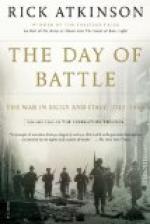‘The very foundations of the city were torn up,’ wrote the Field-Marshal in his official report; ’not hundreds, but thousands of barricades crossed the streets. Such circumspection and audacity were displayed that it was evident military leaders were at the head of the people. The character of the Milanese had become quite changed. Fanaticism had seized every rank and age and both sexes.’
As always happens with street-fighting, the number of the slain has never been really known; the loss of the citizens was small compared with that of the Austrians, who, according to some authorities, lost 5000, between killed and wounded.
Radetsky ordered the evacuation of the town and citadel on the night of Wednesday, the 22nd of March. The Milanese had won much more than freedom—they had won the right to it. And what they had done they had done alone. When the news that the capital was up in arms spread through Lombardy, there was but one gallant impulse, to fly to its aid. But the earliest to arrive, Giuseppe Martinengo Cesaresco, with his troop of Brescian peasants, found when he reached Milan that they were a few hours too late to share in the last shots fired upon the retreating Austrians.
Nowhere, except in Milan, did the revolution meet with a Radetsky. The Austrian authorities became convinced that their position was untenable, and they desired to avoid a useless sacrifice of life. This, rather than cowardly fears, was the motive which induced Count Palffy and Count Zichy, the civil and military governors of Venice, to yield the city without deluging it in blood. The latter had been guilty of negligence in leaving the Venetian arsenal in charge of troops so untrustworthy that Manin could take it on the 22nd of March by a simple display of his own




